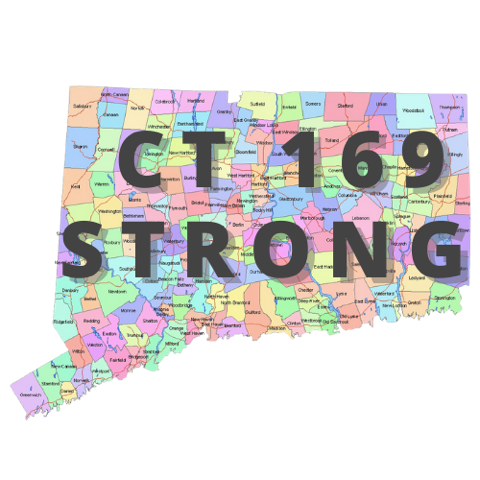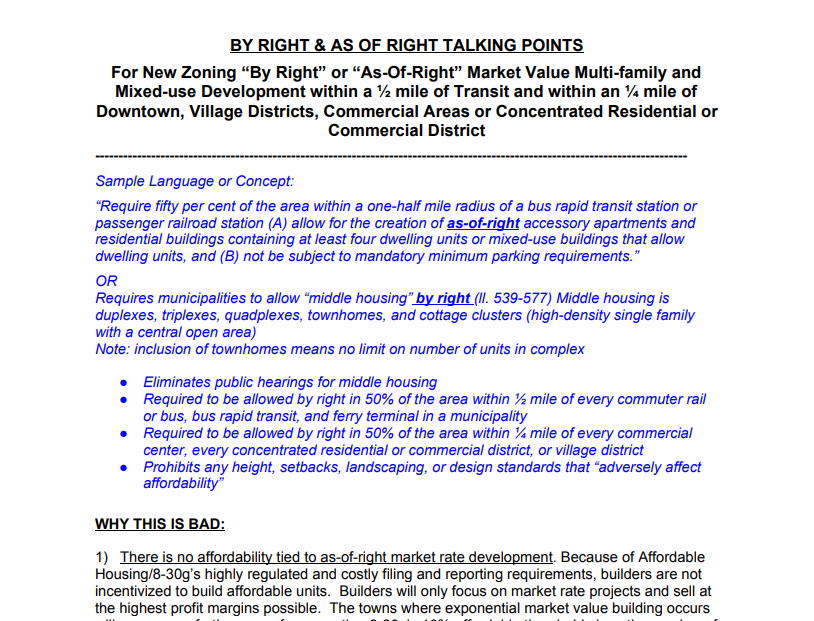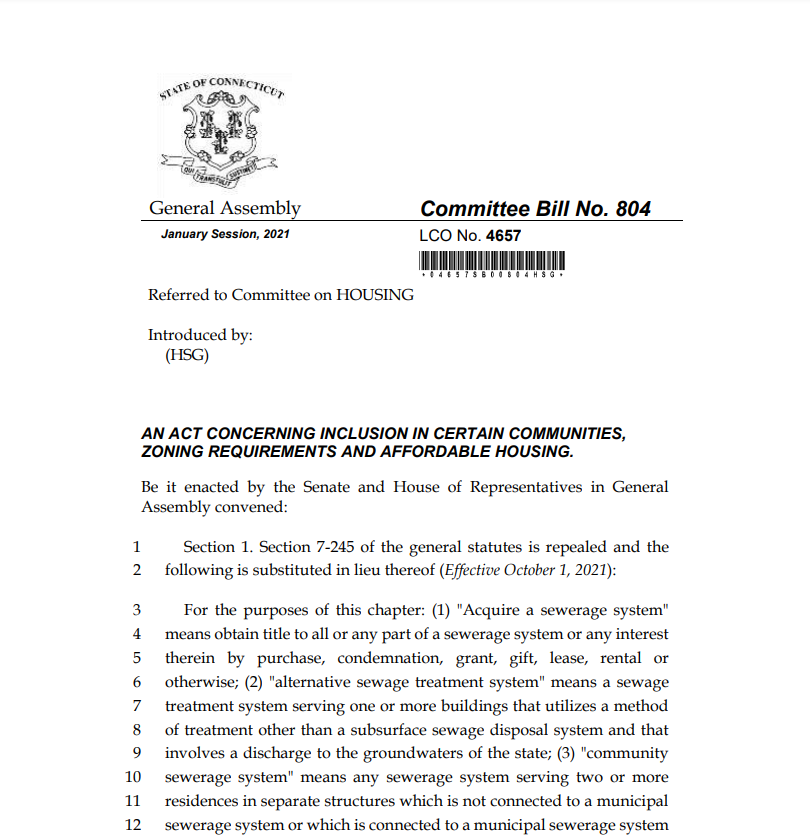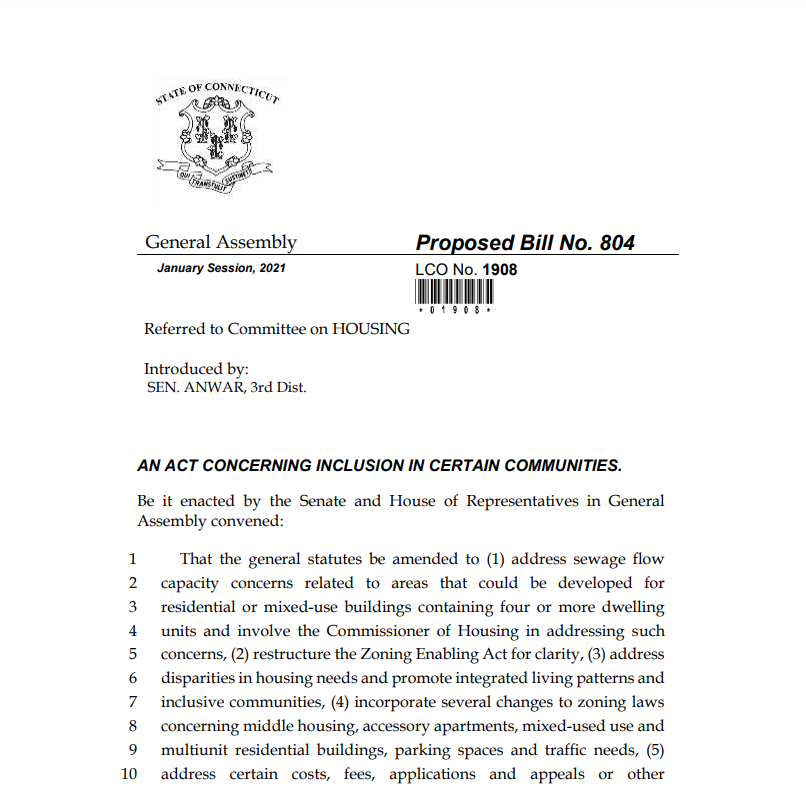Housing Committee Bill and Why We Oppose It
Click “+” to expand
- Raises the limit for alternative sewage/community sewerage systems from 5,000 gallons (equivalent to 33 one-bedroom, 22 two-bedroom, or 11 three-bedroom homes) to 7,500 gallons per day (50 one-bedroom, 25 two-bedroom, or 16 three-bedroom homes) (ll. 20, 84-85)
- Enables more homes to be served in unsewered areas
- Unclear DEEP/DPH position on this and how it may affect their oversight
- Why is this new threshold being proposed? What is the problem that is addressing? Specificity of number suggests a situation in mind
- Requires water pollution control authorities to set aside capacity for apartments (ll. 67-70).
- Tells WPCA how to do their jobs.
- Puts multifamily housing ahead of other uses (e.g. industrial).
- No provision for WPCAs at capacity with current or future projects. Will result in high development costs to expand capacity through tax dollars.
- Replaces “character” with “physical suitability” (ll. 241-242)
- No consideration of economic suitability, e.g. a “farming community” or a “manufacturing zone” or a “biotech cluster”
- Requires zoning to include the “express allowance of housing that could feasibly be occupied by both low and moderate-income households” (ll. 261-262)
- Confusion between planning and zoning; plans do not have the power to allow
- Requires zoning to “expressly allow” (rather than encourage) “the development of housing which will meet the housing needs identified in the state’s consolidated plan for housing” and the state POCD (l. 264)
- State housing and POCD now set parameters for local zoning
- No consideration of statutorily-required affordable housing plans (CGS §8-30j)
- Why even address this locally then?
- Requires zoning to provide for accessory dwelling units (ADUs), middle housing, and mixed-use buildings with at least 4 dwelling units
- Requires municipalities to allow ADUS units by right (ll. 467-538)
- Eliminates public hearings for ADUs
- Required to be allowed by right in all lots of at least 20,000 square feet (approx. 1/2 acre) that either has a single-family home or is zoned for single family homes
- ADUs must be allowed within, attached to, or detached from primary dwelling (municipalities cannot prohibit ADUs in additions or outbuildings)
- Municipality cannot set a maximum size of ADU less than the lesser of 30% of the primary dwelling unit or 1200 square feet
- 1200 square foot ADU is the size of many single-family homes (average home in 1950 was approx. 1500 square feet)
- Essentially doubles housing unit density in most of the state without going through the subdivision process
- Overrides local setbacks; max 10 feet from side and rear lot line
- ADU setback often less than setback for home or outbuilding (e.g. detached garage)
- Prohibits requiring parking for ADUs
- Prohibits conditioning ADU on correction of nonconforming use
- Prohibits any height, landscaping, or design standards that “adversely affect affordability”
- Prohibits municipalities from using/imposing “additional standards beyond those set forth” in the bill
- Guts the ability to regulate ADUs as most standards can be argued to affect affordability – ADUs essentially exempted from any PZ oversight
- Requires municipalities to allow “middle housing” by right (ll. 539-577)
- Middle housing is duplexes, triplexes, quadplexes, townhomes, and cottage clusters (high-density single family with a central open area)
- Note: inclusion of townhomes means no limit on number of units in complex
- Eliminates public hearings for middle housing
- Required to be allowed by right in 50% of the area within ½ mile of every commuter rail or bus, bus rapid transit, and ferry terminal in a municipality
- Required to be allowed by right in 50% of the area within ¼ mile of every commercial center, every concentrated residential or commercial district, or village district
- Prohibits any height, setbacks, landscaping, or design standards that “adversely affect affordability”
- Prohibits conditioning middle housing on correction of nonconforming use
- Prohibits municipalities from using/imposing “additional standards beyond those set forth” in the bill
- Guts the ability to regulate ADUs as most standards can be argued to affect affordability – most housing of 2+ units essentially exempted from any PZ oversight
- Eviscerates any inclusionary zoning regulations
- Caps fees for municipal approvals at $250 per unit (ll. 602-604)
- Regardless of project complexity or unit size
- In-house costs of reviewing projects may exceed this
- Potential cost shift from applicant to existing taxpayers or inadequate reviews
- Undermines affordable housing trust funds that are funded by approval fees
- Prohibits municipalities from requiring affordable housing applications analyses to go beyond the Fire Safety Code (ll. 646-649)
- Focus on building design only, not emergency response
- Eliminates ability for municipalities to consider ability to respond (e.g., a municipality may not have the equipment needed to serve a tall building, or may not have the staffing and engines needed to serve a large number of units)
- Ethics of applying a lower level of risk assessment to residents of affordable housing!
- Enables court to award attorneys’ fees to 8-30g plaintiffs (ll. 671-673)
- May increase costs of 8-30g litigation for municipalities
- Limits the ability of third parties to intervene in 8-30g proceedings (ll. 1463-1470)
- Limits the ability of the public to participate
- Gives a 20% housing unit equivalent point bonus for developments built without the affordable housing appeals procedure (ll. 800-805)
- Incentive not to go through 8-30g for municipalities
- BUT bill would eviscerate inclusionary zoning, so it is unclear whether this would come into play
- The ADUs and middle housing required by right have no affordability requirements; by forcing more market-rate housing, the bill may force municipalities away from the 10% goal under 8-30g, rather than draw them toward it
- Establishes process to create “model zoning guidelines for municipalities to adopt” (ll. 819-853)
- Unclear if this adoption is voluntary or required
- Enables public housing authorities to expand their jurisdiction to (very) high opportunity census tracts within a 15-mile radius of the authority’s home municipality (ll. 854-1147)
- No extension of eminent domain or police authority
- Unclear on ability for local oversight of Housing Projects by a town’s own housing authority.
- Requires PZC, ZBA, and IWWC members to take 4 hours of training annually
- At least 2 hours on affordable and fair housing annually
- How to compel volunteers to take more time? Question of participation
- Question of applicability of training – is 2 hours every year on affordable housing the best and most pressing issue?
- Would require zoning restrict development on ridgelines and to prohibit clear cutting and quarrying (ll. 344-352)
- Enable PZCs to terminate nonconforming uses after a certain period of time (ll. 402-409)
- Runs counter to a recent public act that establishes the right to maintain a nonconformity as long as the property owner intends to continue its use (PA 17-39)
- Enables termination of nonconforming uses even if they have been continued







